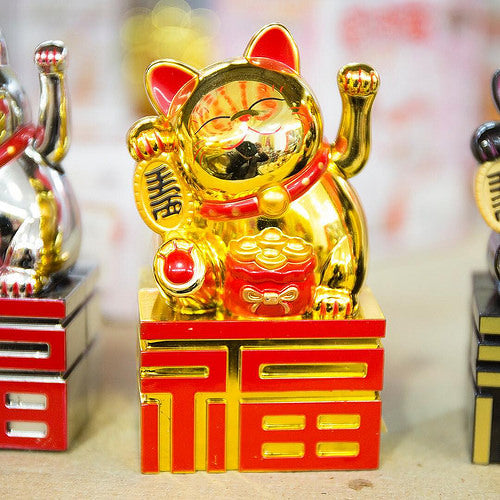
A Brief History of Cats in Asian Culture
With a lucky cat as our unofficial mascot, we’re more than a little excited about National Cat Day on October 29. It also gives us the excuse to explore the role our furry friends have played in China, Japan, and other Asian countries. Here are eight things you might not know about cats in Asian culture.
Cats have been purring in Chinese homes for over 5,000 years
Back in 2001, Chinese researchers discovered cat bones in agricultural settlements in Shaanxi Province. They determined the bones were from around 3500 BC but couldn’t tell if they were from small wild cats or from doted-on pets. Only recently were scientists able to establish they belonged to the leopard cat, a distant cousin of the western wildcat, otherwise known as the great-great-great-great-granddaddy of all modern domesticated cats.
But there’s no Year of the Cat
Despite its long history in China, the Chinese zodiac has no cat. Legend says the rat neglected to wake the sleepy cat on the day of the race that would determine which animals would be included in the zodiac. As a result, the cat missed the race (and hated the rat from then on, natch). Another theory says cats as pets simply weren’t a thing when the zodiac was created.
In Vietnam, however, it’s a different story

The Vietnamese calendar borrowed from the Chinese but replaced the ox with the buffalo and the rabbit with the cat. The former is understandable: the water buffalo, a prized possession among farmers, is the national symbol of Vietnam. But why the latter?
One theory says it has to do with a word mixup. While the Chinese word for rabbit is tùzǐ, there’s another word that refers specifically to the Year of the Rabbit: mǎo, which sounds a lot like māo, the Chinese word for cat, which also sounds a lot like the Vietnamese word for cat, mèo.
Cats arrived in Japan as stowaways

There's no denying Japan is cat crazy. But how did the critters get there?
In the mid-sixth century, Japanese ships arrived home from China with sacred Buddhist scriptures. But those ships had other cargo: cats. By the Edo Period (1615-1868), the country was hooked, judging by the plethora of cat-themed art from that time.
The maneki neko has mysterious origins

(Photo via Japan Times)
The lucky maneki neko with its beckoning paw (left for customers, right for money) is ubiquitous in Asian businesses. But where it comes from, no one seems to know for sure.
While the earliest mention of a maneki neko statue might be from a 1852 diary kept by a state official, the stories behind the lucky cat are many and varied. One says a samurai (or a feudal lord or a rich guy) who had taken refuge from a rainstorm under a tree was beckoned by a cat to enter a temple – immediately after which a lightning bolt struck the formerly sheltering tree.

Another stars a geisha, her beloved feline, a hot-headed guest, and a lurking snake. The guest, mistaking the cat’s pawing his owner for clawing, cut off the poor kitty’s head, which conveniently landed on a snake that was about to attack the geisha. “My bad,” the guest said, and commissioned a wooden cat to be carved in the likeness of the geisha’s beheaded cat.
As for how the cat ended up as a good luck charm specifically for businesses, one seedy claim ties it to brothels. These houses of ill repute were said to use phallic symbols as advertisement. However, when more (presumably prudish) Americans and Europeans began visiting in the 18th century, the phalluses were swapped out for the friendlier maneki neko. Soon, other businesses picked up the habit, and the rest is history.
Hello Kitty isn’t a cat, Japanese, or named Hello Kitty
In the 1960s, silk and produce company Sanrio started a line of kawaii items that were a perfect fit for Japan’s propensity for giving small gifts for almost any occasion. Hello Kitty was one of the results.
However, according to the company behind the mouthless sensation, she’s not a cat. She’s a cartoon character, a little girl, and a friend. But not a cat. She’s also not Japanese. She’s British, named Kitty White, and has a twin sister named Mimmy. Put that in your saucer and drink it.
Japan has over 150 cat cafes
In addition to Hello Kitty Land, Japan is home to over 150 cafes that let patrons pet and play with kitties. However, credit for the world’s very first cat cafe goes to Taiwan: Taipei's Cat Flower Garden opened in 1998.
You can visit a whole village and island of cats
Houtong, a former coal mining village in northern Taiwan, is home to over 200 cats – and a burgeoning cat tourist industry. In addition to the fur balls, visiting felinophines can enjoy kitty-themed shops and cafes, check out some catty tchotchkes, and snap selfies with cat statues.

They don't call it Cat Island for nothing. (Photo via Catster)
Meanwhile, Japan has about a dozen “cat islands.” On Aoshima Island, the feline residents clock in at over 100, outnumbering humans six to one. (And in case you’re wondering, a neutering program has begun on Aoshima and the other cat islands to humanely control the populations.)
Still not enough cats for you? Shop our collection of cute cat mugs, bowls, figurines, and more.